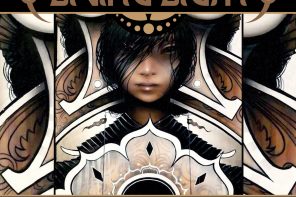To download and donate to his newest album, visit the Pretty Lights Music Site.
On the 3rd day of April, Gramatik dropped his highly anticipated second release on the Pretty Lights Music Label, #DigitalFreedom EP. Those familiar with Gramatik’s previous album, Beatz & Pieces Vol. 1, may be quite surprised with his new material. A transformation into hyphy, club-banging, party-rocking, dubstep beats has left most fans elated and blown away. Others are skeptical that #DigitalFreedom was forced into the mainstream vein and untrue to his roots.
Regardless of the critics, Gramatik has shown his versatility as a producer – not only by transcending genres, but by switching up the mood and the feel of his sound with high-quality electronic music as the common denominator. Lost in Sound was able to catch up with the Slovenian native on his relationship with PLM family, his Eastern European roots, the Occupy movement, and his girlfriend. Tune into his new album below, and keep scrolling for the interview!
LIS: You’re originally from Slovenia. Were you ever inspired by Slovenian music? What’s it like?
G: If you’re talking about Slovenian folk music, it’s pretty much the same as Austrian folk music, that happy Polka shit. Not really my cup of tea. But popular music is pretty much the same as everywhere else, there were maybe 2 or 3 artists from back home that I listened to growing up.
LIS: Who was your biggest influence when you were first introduced to American music?
G: I wasn’t introduced to American music. American music is present everywhere in the Western World since Day 1. So, much like you, I grew up with it.
LIS: Did you ever go to live shows in Slovenia?
G: Yea, I went to a lot of shows. I come from a small town in Slovenia on the border of Italy. My hometown has one of the biggest clubs in Europe, Ambasada Gavioli. The architect was a famous Italian guy. So he designed the club and it’s really sick, it’s like a work of art, the walls have these weird, creepy features all in dark red and black. Looks like hell. That started in ’92 and ’94. It was technically my hometown, so all the biggest raves and techno names and even to this day, come and play regularly, you know Richie Hawtin, etc. Techno, tech-house and stuff like that, so we got exposed to that at an early age.
We have a fairly big hip-hop scene considering it’s a country of 2 million people – nothing can really be huge you know? 300,000 maybe, listen to music, how many listen to electronic and hip-hop? There’s a little bit of everything there but nothing that can make an actual scene. Hip-hop is definitely the biggest scene right now in Slovenia and then house and techno, because it’s Europe obviously. I’m basically the only artist in Slovenia that does what we do at PLM. In the capital city it’s slowly developing, but nothing that would create a scene, so I always focus more on taking it outside.
LIS: What do you think is the biggest factor that helped you get out of Slovenia, and when did that happen?
G: Definitely Beatport, you know it’s worldwide, so when my tracks started coming up, people really started showing up. That’s how I got to PGA, Progressive Global Agency. They saw me at #1 Chill-Out Track, and I didn’t have an agent in North America. I hadn’t had any shows before that got me out of the country. It was really a nice jumping stone.
LIS: So, it’s really the digital trade of information.
G: Exactly. Yeah, it’s so hard for artists to come out of their local areas, but now we have iTunes and Beatport. BP is still pretty much electronic, although now with the new re-designing, they’re starting with pop and rock. That’s what happens when corporations come in and buy you out, try to make you as liquid as possible. There’s always that greed factor.
LIS: There’s something going on about that now?
G: Right yea, Occupy, should have happened like 20 years ago.
LIS: Did you go to school?
G: I studied Audio Engineering and I didn’t finish high school. I fucking hated it. I wanted to focus on my music and then SAE Institute promoting “practical creative media education” came around, and they didn’t need a high school diploma, because there isn’t one for that. If you got it, you got it, and you’re in. In general I never liked school, it felt unnatural. School should be something you go to and have a variety of things you can learn and you pick them. Trying to force someone to learn something that he hates, just for getting the “A?” I have friends who finished college just to get the “A” and they have shitty jobs that they hate, and that’s why Occupy is happening; because the school system is not working. It’s not enough. We are not robots – we are dynamic, not static. We can’t do the same thing over and over again; it destroys the soul. If we have soul, we should cherish it and look after it.
LIS: So you see Occupy in every city now?
G: Yea, definitely. A lot of people are misguided, but the ones that are actually there are really there and making arguments. Most of the media owned by corporations portray them as just pot heads against capitalism, but everyone knows that’s not the case. It’s like, fuck you, who are you trying to portray? It’s right in your face.
LIS: I wonder if it will go outside the US?
G: Well yea, Occupy started in Brussels and Spain, then went to Wall Street and that’s when it got the main attention. Once something gets major attention in the States, then everyone hears about it, which is good you know, as long as the message gets across.
LIS: What about in Slovenia?
G: Yea, a little in our capital city, hoping to see more of it and hoping they keep it peaceful and rational. You know people are there beating people up, fucked up. I don’t know if you guys have seen on Fox News, the British when they went to Wall Street. One of the guys literally destroyed the reporter, but it got censored. We have an expression for that: he took him by his hand, so he can help him take a piss – it showed really nicely what Occupy is about. He actually had a concrete factual argument backed up with ideology. Not hippie, not radical, not anarchist, just rational human beings trying to fix a problem that’s been happening for 50 years. Oh yea, I support that definitely.
Gramatik with Michal Menert at Paradise Club in Boston on November 11, 2011
Photo by Margaret Quigley
LIS: What has it been like being a part of Pretty Lights Music Record Label and touring with other artists on the label?
G: It’s super fun, and we inspire each other creatively. Everyone is doing their own thing, but we all do it with the same kind of passion and love for the music.
LIS: Do you think that’s because you and PLM are similar?
G: Definitely, we started kicking it when our first albums were coming out. We always shared visions and this same kind of genre we grew up with and love listening to. Signing was just a normal thing to do. I was getting bullshit from Cold Busted and wanted to be in a real environment around people that are my homies.
LIS: Did you meet Pretty Lights at Red Rocks?
G: We met in 2009 during his first major fall tour. At the same time I signed with PGA, and we had the same agent. We shared albums and liked each other. He saw that I have the same vision.
LIS: The Street Bangerz albums have something like 20 tracks on each of them, which is a lot more than any other producer. How are you able to pump out that many tracks?
G: Street Bangerz started out as raw hip-hop beats about 2-3 minutes long, so I just wanted to put a bunch on because they’re short. Usually in electronic, most are 4-5 minutes long, so I was like you know, I want to put 20 beats on there. If you put less and longer it gets boring, and is not as effective. Then later on, I started expanding the arrangements by adding live instrumentation and that’s where I got to the sound I’m at now, No Shortcuts. So this is the album I’m most proud of, it’s my most cohesive. My next album, I’ve Never Been The Silent Type, is progressing with electro, glitch, funk, hip-hop and hopefully every track will have my signature on it.
LIS: Many electronic artists use samples in their music. What do you do to make your sample sounds unique?
G: I fuck with the sample in any way that I know to make it sound unique.
LIS: What’s the most amount of samples you’ve used in a song?
G: In “Boom Bap Reinstated”, I sampled 9 different songs. I think that’s still a personal record. It’s collage sampling at that point, next level shit.
LIS: Who does your organic sounds?
G: I play keys and the bass lines and electric piano and then I have a couple friends that are really good pianists, and FAQ plays guitar with me on stage. We experiment a lot, sometimes I’d pick up the bass guitar and chop that up. I do everything in Ableton.
LIS: Where is FAQ from?
G: He’s from my hometown. He just dropped a single on Dream Big Music. All of us dream about the same thing, having our own label, releasing our own music. I started the label last year, which is just to release my free stuff, not selling anything. We started a collective, me and him and some graphic designers. He’s really good, does websites, video production, so you know theres a bunch of us like that in this collective. Very able and versatile and can do a bunch of different things. We grew up in an environment where there was no one around to help us with that, so we are self-sustainable. We gotta’ learn it all and do it all ourselves. It’s a fairly new craft, you know? Digital technology. We always have the audacity to dream big.
LIS: What are your future plans for incorporating live music into your performances?
G: Ever since I started touring in 2009, I’ve always had someone on stage with me contributing something to the live act. My good friend FAQ has been playing the guitar with me on stage since 2010. Future plans are pretty much unknown, because I always go with the flow on these things.
LIS: Gramatik vs. Gr4m4tik. Can you explain the difference? What inspired the genre change?
G: It wasn’t a genre change. I experiment with all kinds of genres that I like, and Expedition 44 was my take on tech-house, electro house and the rest of the 4 to the floor genres. It was a compilation of tracks that I made between 2008 and 2009. I dropped it for free under Gr4m4tik so people know it was just a side project of mine. It’s not something I ever planned to continue.
LIS: Do you ever play Gr4m4tik during your sets?
G: I never play any of the Gr4m4tik tracks.
LIS: You’re already on the line-up for 2012’s Wakarusa, Electric Forest, and Wanderlust. What are you looking forward to most this summer?
G: I’m definitely excited about Electric Forest, it’s gonna be huge this year. There is one other thing I’m even more excited for, but I can’t talk about it yet.
LIS: What advice would you give to aspiring producers about starting out?
G: Install Ableton Live and get ready to say goodbye to your social life.
LIS: Indica or sativa?
G: We have a lot of good weed in Slovenia because we’re in Central Europe. Slovenia is 61% countryside, so people grow it and it’s really good outdoor. And at the same time, you have people that grow MAD hydro, so we’re always spoiled with that. And in America it’s not doing bad. There’s good weed everywhere. Big cities like Italty, there’s mostly hash which sucks, not a huge fan. Clogs your lungs, can only smoke it once in a while, not for me personally. To see Gramatik and his girlfriend, click here.
LIS: Anything else you’d like to tell your fans?
G: Brush your teeth, eat your vegetables, and DREAM BIG!
To download and donate to his newest album, visit the Pretty Lights Music Site.
Gramatik on Facebook
Gramatik on Twitter
Gramatik on SoundCloud
This is an official video produced by Gramatik’s friend Luka Tisler, constructed out of footage from the Gramatik US Fall Tour 2009.






